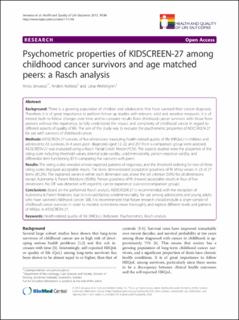Please use this identifier to cite or link to this item:
https://doi.org/10.21256/zhaw-3911Full metadata record
| DC Field | Value | Language |
|---|---|---|
| dc.contributor.author | Jervaeus, Anna | - |
| dc.contributor.author | Kottorp, Anders | - |
| dc.contributor.author | Wettergren, Lena | - |
| dc.date.accessioned | 2018-07-27T12:24:40Z | - |
| dc.date.available | 2018-07-27T12:24:40Z | - |
| dc.date.issued | 2013 | - |
| dc.identifier.issn | 1477-7525 | de_CH |
| dc.identifier.uri | https://digitalcollection.zhaw.ch/handle/11475/8708 | - |
| dc.description.abstract | Background: There is a growing population of children and adolescents that have survived their cancer diagnosis. Therefore, it is of great importance to perform follow-up studies with relevant, valid and sensitive measures. It is of interest both to follow changes over time and to compare results from childhood cancer survivors with those from persons without this experience, to fully understand the impact and complexity of childhood cancer in regard to different aspects of quality of life. The aim of this study was to evaluate the psychometric properties of KIDCSREEN-27 for use with survivors of childhood cancer. Methods: KIDSCREEN-27 consists of five dimensions measuring health-related quality of life (HRQoL) in children and adolescents; 63 survivors, (4–6 years post- diagnosis) aged 12–22 and 257 from a comparison group were assessed. KIDSCREEN-27 was evaluated using a Rasch Partial Credit Model (PCM). The aspects studied were the properties of the rating scale including threshold values, internal scale validity, unidimensionality, person response validity, and differential item functioning (DIF) comparing the survivors with peers. Results: The rating scales revealed almost expected patterns of responses, and the threshold ordering for two of three rating scales displayed acceptable results. The items demonstrated acceptable goodness-of-fit MnSq values in 23 of 27 items (85.2%). The explained variance within each dimension was above the set criterion (50%) for all dimensions except Autonomy & Parent Relations (39.8%). Person goodness-of-fit showed acceptable results in four of five dimensions. No DIF was detected with regard to cancer experience (survivors/comparison group). Conclusions: Based on the performed Rasch analysis, KIDSCREEN-27 is recommended, with the exception of Autonomy & Parent Relations, due to non-satisfactory unidimensionality, for use among adolescents and young adults who have survived childhood cancer. Still, it is recommended that future research should include a larger sample of childhood cancer survivors in order to monitor some items more thoroughly and explore different levels and patterns of HRQoL in KIDSCREEN-27. | de_CH |
| dc.language.iso | en | de_CH |
| dc.publisher | BioMed Central | de_CH |
| dc.relation.ispartof | Health and Quality of Life Outcomes | de_CH |
| dc.rights | http://creativecommons.org/licenses/by/2.0/ | de_CH |
| dc.subject | Neoplasm | de_CH |
| dc.subject | Parent-child relation | de_CH |
| dc.subject | Psychometrics | de_CH |
| dc.subject | Quality of life | de_CH |
| dc.subject | Reproducibility of result | de_CH |
| dc.subject | Social environment | de_CH |
| dc.subject | Social support | de_CH |
| dc.subject | Health-related quality of life (HRQoL) | de_CH |
| dc.subject | Rasch analysis | de_CH |
| dc.subject.ddc | 305: Personengruppen (Alter, Herkunft, Geschlecht, Einkommen) | de_CH |
| dc.subject.ddc | 610: Medizin und Gesundheit | de_CH |
| dc.title | Psychometric properties of KIDSCREEN-27 among childhood cancer survivors and age matched peers : a Rasch analysis | de_CH |
| dc.type | Beitrag in wissenschaftlicher Zeitschrift | de_CH |
| dcterms.type | Text | de_CH |
| zhaw.departement | Gesundheit | de_CH |
| zhaw.organisationalunit | Institut für Ergotherapie (IER) | de_CH |
| dc.identifier.doi | 10.21256/zhaw-3911 | - |
| dc.identifier.doi | 10.1186/1477-7525-11-96 | de_CH |
| dc.identifier.pmid | 23764269 | de_CH |
| zhaw.funding.eu | No | de_CH |
| zhaw.issue | 96 | de_CH |
| zhaw.originated.zhaw | Yes | de_CH |
| zhaw.publication.status | publishedVersion | de_CH |
| zhaw.volume | 11 | de_CH |
| zhaw.publication.review | Peer review (Publikation) | de_CH |
| Appears in collections: | Publikationen Gesundheit | |
Files in This Item:
| File | Description | Size | Format | |
|---|---|---|---|---|
| 2013_Kottorp_Psychometric_properties_Kidscreen-27.pdf | 374.39 kB | Adobe PDF |  View/Open |
Show simple item record
Jervaeus, A., Kottorp, A., & Wettergren, L. (2013). Psychometric properties of KIDSCREEN-27 among childhood cancer survivors and age matched peers : a Rasch analysis. Health and Quality of Life Outcomes, 11(96). https://doi.org/10.21256/zhaw-3911
Jervaeus, A., Kottorp, A. and Wettergren, L. (2013) ‘Psychometric properties of KIDSCREEN-27 among childhood cancer survivors and age matched peers : a Rasch analysis’, Health and Quality of Life Outcomes, 11(96). Available at: https://doi.org/10.21256/zhaw-3911.
A. Jervaeus, A. Kottorp, and L. Wettergren, “Psychometric properties of KIDSCREEN-27 among childhood cancer survivors and age matched peers : a Rasch analysis,” Health and Quality of Life Outcomes, vol. 11, no. 96, 2013, doi: 10.21256/zhaw-3911.
JERVAEUS, Anna, Anders KOTTORP und Lena WETTERGREN, 2013. Psychometric properties of KIDSCREEN-27 among childhood cancer survivors and age matched peers : a Rasch analysis. Health and Quality of Life Outcomes. 2013. Bd. 11, Nr. 96. DOI 10.21256/zhaw-3911
Jervaeus, Anna, Anders Kottorp, and Lena Wettergren. 2013. “Psychometric Properties of KIDSCREEN-27 among Childhood Cancer Survivors and Age Matched Peers : A Rasch Analysis.” Health and Quality of Life Outcomes 11 (96). https://doi.org/10.21256/zhaw-3911.
Jervaeus, Anna, et al. “Psychometric Properties of KIDSCREEN-27 among Childhood Cancer Survivors and Age Matched Peers : A Rasch Analysis.” Health and Quality of Life Outcomes, vol. 11, no. 96, 2013, https://doi.org/10.21256/zhaw-3911.
Items in DSpace are protected by copyright, with all rights reserved, unless otherwise indicated.